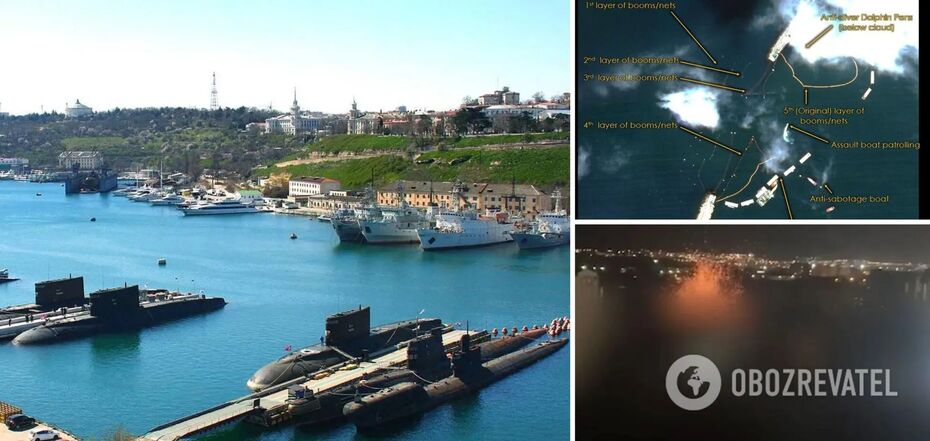War in Ukraine
Even dolphins were used: the occupiers strengthened the defense of Crimea after the "bavovna" in Sevastopol
Russian troops established six defense echelons in the city bay of Sevastopol in temporarily occupied Crimea. The invaders patrol the territory from ships and helicopters, and they also put combat dolphins on "duty".
The enemy resorted to such actions after the last "bavovna" on this base of the Black Sea Fleet, which since the summer of 2022 is constantly subjected to strikes by the AFU. This was reported by an OSINT analyst who runs the Twitter account HI Sutton (to see the photo, scroll to the end of the news).
According to him, the approach to the port of Sevastopol is now protected by at least six rows of physical barriers. In addition, the water area is patrolled by boats and monitored from the air.
The analyst adds that after a successful attack by the Ukrainian Armed Forces on the port of Sevastopol in October last year, booby traps were placed at the entrance to the bay and inside the port. The Russians also installed two layers of floating nets in front of the entrance, blocked part of the passage, and placed six barges there.
"Few things could be a more visible sign of Russia's more defensive posture than six layers of nets and booms across the Sevastopol harbor. The enhanced defense is primarily aimed at Ukraine's maritime drones. The attack on the Crimean port on April 24, 2023 shows how the situation is heating up," the expert writes.
According to him, after a series of last year's "bavovna", Russia is making "large-scale efforts" to strengthen the protection of Sevastopol Bay from Ukrainian attacks. Thus, the new six layers of physical barriers are in addition to patrol boats, helicopter patrols, combat dolphins and firing points.
"Sevastopol is the main naval base of the Russian Navy in Crimea. Although there have been attempts to disperse key assets to other bases, such as Feodosia, the main warships are located there. Therefore, it remains a key target for Ukraine, especially in the face of any planned counteroffensive," HI Sutton said.
He added that the original floating booms at the entrance to Sevastopol Bay were intended to contain oil spills and prevent any attack. At the beginning of the invasion, the threat of attacks by Ukrainian surface ships seemed "old-fashioned and extremely unlikely" to the occupiers. However, the floating boom that existed before was still sometimes closed by the Russians to prevent the entry of unauthorized boats.
In October 2022, the OSINT analyst emphasizes, Ukraine conducted an impressive maritime drone attack on Sevastopol. Several ships were hit, but none were seriously damaged. However, this exposed the ineffectiveness of the old defenses. Subsequently, in November, the occupiers added more powerful protective boom barriers both at the harbor entrance and in various places inside the port.
"The reinforced defense seemed more serious than many might have thought at the beginning of the war. However, on March 22, 2023, Ukrainian naval drones struck again. Although they did not cause serious damage, they penetrated the inner harbor. The latest defense measures are likely a response to this. Two more layers of floating nets were placed on the outside of the harbor entrance. A series of six large pontoon barges are anchored there. In fact, they expand the harbor wall, narrowing the entrance. Presumably, additional obstacles are stretched between them," the expert explained the sequence of events.
He also analyzed radar satellite images of the bay, according to which the occupiers began deploying pontoon barges between April 3 and 9 and their number has increased since then. They are now stationed on both sides of the harbor entrance.
"It is not yet known whether the latest Ukrainian maritime drone attack was intercepted because of the new defenses. It is possible that, knowing about these defenses, Ukraine deliberately targeted outside the harbor. In any case, this attack should be viewed in the broader context of the expected Ukrainian counteroffensive. It shows that Russia will have to continue to invest in the defense of its bases in Crimea," the OSINT analyst said.
As OBOZREVATEL reported, a series of explosions shook Sevastopol in the dark on April 24, and the occupiers were quick to justify that it was a "drone attack". In the morning, footage of the aftermath of the "bavovna" that woke up the entire city appeared on the Internet.
Only verified information is available in our Telegram-channel Obozrevatel and Viber. Do not fall for fakes!






























